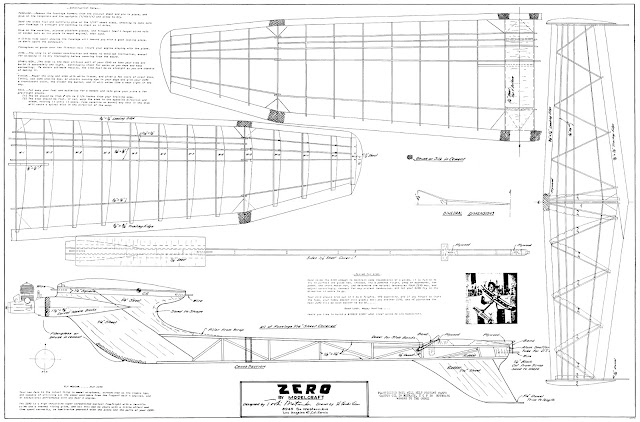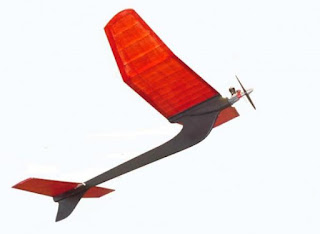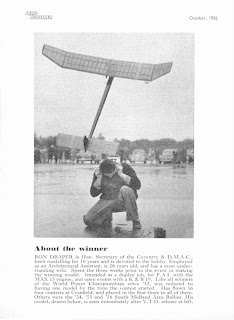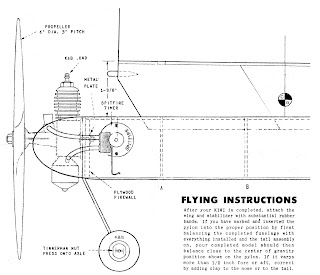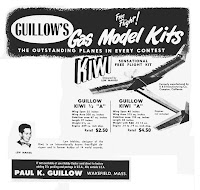SATELLITE 1000 de Bill Hunter. USA. 1971.
Satellite 1000 Clase C de 1971.
Este modelo posee un record registrado de permanencia en vuelo
de 73 Minutos 24 seg logrado en 1971.
Ver también Satellite 226 -1\2 A
Este modelo posee un record registrado de permanencia en vuelo
de 73 Minutos 24 seg logrado en 1971.
Ver también Satellite 226 -1\2 A
May 1972 American Aircraft Modeler
by Bill Hunter
The original Satellite 1000 was built in early 1959 to compete in the ultra-high power loading weight rule of that year. The wing was built around the outline of the existing Satellite Series "57" plans. This 1000 Class S job, bigger than I was at the time, was powered by a super hot Johnson 29R swinging a 10x4 Grish nylon prop. The ultra-high loading rules made a "B" ship weigh 52.9 oz.-what a terrible chore building a model that heavy. The fuselage was a fiberglass fishing rod and the pylon was solid 1/2" plywood, which alone weighed 16 oz.
Even so, it collected a lot of hardware that year, including first place Junior S Gas at the 1959 Nats-a major point contribution towards the Junior National Championship. It continued to win consistently the next year, but the wing and stab were lost, along with every other wing and stab my father and I owned, on the highway outside of Sly the, California on our way to the 1960 Nats at NAS Dallas-the top of the car carrier blew off at 70 mph! I don't think I'll ever forget the sight and sound of cars and trucks rolling over the product of our years of preparation. Lucky my fuselage was so heavy or it would have been sucked out with everything else.
Free-flight modeling has seen a multitude of rule changes since that time. Weight impositions have long since been removed, engines have become much more powerful, and a new Satellite 1000 is making the contest scene, proving itself winner in all contests entered.
The Series 70 Satellite 1000 "C" Special was designed especially for the brute power delivered by the K&S 40RR. If a thousand square inches of wing area seems a little large, take all factors into consideration" The Satellite features an elliptical wing and stab that offer more than just pleasing lines. Consider for a moment what happens to the 9% flat bottom section as it moves from the center to the tips of the wing.
Right, it becomes much thinner. Since the wing is elliptical, the 14-11/16" chord at the center section becomes 12-1/8" at the tip dihedral break, and, in proportion, the 9% section at the tip dihedral break is considerably thinner. As a re-' suit, drag is enormously reduced, allowing the ship to move under power like a 700 sq. in. job of the typical square design. When the Satellite flips out on top however, you get everyone of those thousand squares back, giving this ship a glide second to none-as witnessed by many at the San Valeers Annual, November 14, 1971 at Taft, California. Seven ships maxed out on Saturday including both the Satellite "C" Specials entered. Due to a sudden dust and rainstorm, special flyoffs were held the next morning. Sunday morning dawned clear, cold and calm with little or no lift. Everyone had to fly at approximately the same time, within two minute starting time limit.
This was the perfect situation for power and glide comparisons, as the air was the same for all contenders. The first flyoff was to be a seven-m in. max, increasing by two minutes each succeeding flight. Four of the seven con-tenders were down within six and half minutes. Only one other ship besides the two Satellites maxed. That ship glided down at 7:20-my father's Satellite and mine were up for 8:50 and 9: 14. The next flight saw the two Satellites flip out on top and stay that way. The two Satellite "C" Specials finished in first and second place. Their wings and stabs were covered with one mil Mylar; the fuselages were finished with K&B Superpoxy. The light weight of the Mylar helped hold the all-up weigh of both ships to just under 35 oz., and gave them a 3.5 oz./100 wing loading.
The two "C" Specials first saw competition at the Fresno 31st Annual-September 24 and 25, 1971. This meet allowed the contestants to fly any event scheduled either day. My Dad flew Class C, winning the event and setting a new 1971 Open AMA record of 73:24. I elected to fly my "C" Special. I first entered my plane in a Testors beauty award. The "C" Special won the beauty award, and I began flying official trying to catch my Dad. But it was no use-the ship went out of sight overhead on the second max and was lost. Luckily it was found by a friendly farmer and returned a week later. Then we headed for the Arizona State Championships in Phoenix, where the Satellites took first and third in C Gas. All sizes of the Satellite Series 70 have built up an outstanding win record.
Construction
With ease of construction a prime concern during the design stage of all Series 70 Satellites, detailed assembly descriptions, full-size template drawings, and a bill of materials are part of each plan, so in this case lengthy construction notes found in most articles are not necessary.
We use Titebond glue for all joints, and epoxy for laminations. The Series 70 Satellites are adaptable to several . types of trim methods. Our favorite, as shown on the plans, is the right climb, left glide, achieved by right thrust, left rudder, and left wing washout, all in moderation to achieve a 3/4 right power turn in 15 seconds with a glide turn of 40 to 52 seconds.
VTO is a snap. When you've maxed out, VTO does not apply, so hand launch with your strongest throw to take advantage of the short engine run. The wing is stressed to take it!
F.A.I. POWER de Karl Heinz Rieke. 1969
Este modelo obtuvo el segundo lugar en el concurso mundial de 1969
CUDDY 1\2 A de Tony Cordes. 1973.
En noviembre de 2009 publicamos el primer plano de este modelo, siguiendo el esquema que Don Alfredo Baños gentilmente nos
permitió tomar en el concurso nacional 2008 de su propio modelo. Con algo de tiempo hemos revisado el plano original del modelo publicado por primera vez en AEROMODELLER en Octubre de 1973, y ajustado algunos detalles constructivos.
Alfredo Baños obtuvo múltiples Campeonatos Nacionales de Argentina con este lindo modelo 1\2 A diseñado por el Británico Tony Cordes,
DESCARGUE ESTE PLANO (redibujado) EN PDF AQUÍ
TOTOTL (Aguila Azteca) 1/2 A
Esta (en muy baja resolución) es la única imagen que existe en nuestro archivo de este plano. Si usted desea hacernos llegar una imagen con mayor resolución, déjenos su comentario con la dirección de su correo y los enlaces a esa información. Gracias.
CRESCENDO 62 de Ron Draper .(1955) Campeón Mundial 1956. Inglaterra
El hermoso modelo de Ron Draper voló durante el año 1955 con un motor .19 y fue campeón en la categoría Motor F.A.I con un motor OS .15 en Cranfield, Inglaterra, en el concurso mundial de 1956
Descargar el plano en pdf : OUTERZONE
 Plano de Aeromodeller, dimensiones en pulgadas.
Plano de Aeromodeller, dimensiones en pulgadas.
Descargar el plano en pdf : OUTERZONE
 Plano de Aeromodeller, dimensiones en pulgadas.
Plano de Aeromodeller, dimensiones en pulgadas.KIWI A de Lew Mahieu. USA. 1954
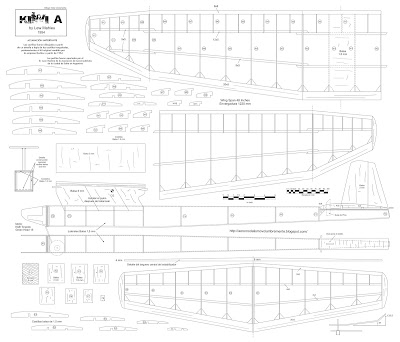
Click Aquí para ver y descargar el plano REDIBUJADO en pdf
EL PLANO ORIGINAL EN PDF AQUÍ
Ver los Comentarios
EL PLANO ORIGINAL EN PDF AQUÍ
Ver los Comentarios
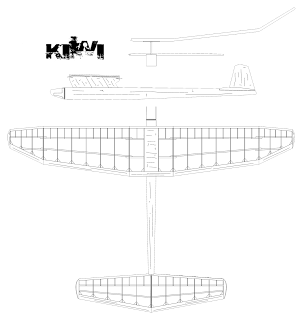

Envergadura 1220 mm.
A propósito de nuestra investigación, he pedido colaboración al notable aeromodelista Argentino Juan Medina de la ciudad de Salta en Argentina, quien muy amablemente acepto colaborar enviándo estas imágenes y estos comentarios para compartir con todos ustedes.
"...mando los perfiles del Kiwi A de la empresa Guillow. Estos perfiles fueron tomados de las costillas originales del kit del año 1954 y es muy probable que con la tecnología de troquelado de la época....
Leer más

Además te envió detalles de la parte frontal del Kiwi 1/2A y del Kiwi A de los planos de la empresa Guillow, en donde en ambos dibujos se describe un único patín que deberá ir ubicado en el parallamas o cuaderna F1.

ACLARACIÓN IMPORTANTE
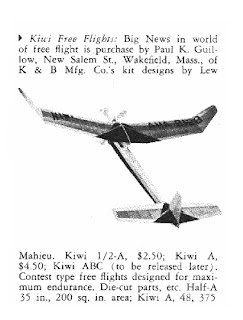 Este es un caso muy interesante en que se pueden apreciar diferencias entre el plano publicado en la parte superior y el de la parte inferior, en este caso el plano pertenece a la K&B Mfg. Co. Algún tiempo antes de que K&B le vendiera los derechos de fabricación y venta a Paul Guillow de Guillow`s Co.
Este es un caso muy interesante en que se pueden apreciar diferencias entre el plano publicado en la parte superior y el de la parte inferior, en este caso el plano pertenece a la K&B Mfg. Co. Algún tiempo antes de que K&B le vendiera los derechos de fabricación y venta a Paul Guillow de Guillow`s Co.
Se pueden apreciar distintos perfiles en el ala y en el estabilizador, distintos momentos de cola, etc, etc.
Es decir que aunque la relación de un plano con el otro parece evidente, no se trata del mismo modelo en otra escala.
He editado el plano
KIWI A-B.
Aquí están las imágenes en las que se muestran
resaltadas las partes que fueron utilizadas para la edición.

Esta es solo otra muestra de todas las tareas implícitas en el trabajo de recopilación y restauración digital, de los planos y artículos que usted encuentra habitualmente en este sitio web.
 En este caso en particular, planos con una antigüedad cercana a los 60 años
En este caso en particular, planos con una antigüedad cercana a los 60 años

Aquí están las imágenes en las que se muestran
resaltadas las partes que fueron utilizadas para la edición.

Esta es solo otra muestra de todas las tareas implícitas en el trabajo de recopilación y restauración digital, de los planos y artículos que usted encuentra habitualmente en este sitio web.
 En este caso en particular, planos con una antigüedad cercana a los 60 años
En este caso en particular, planos con una antigüedad cercana a los 60 años
Ver también las fotografiás del Kiwi de Marcelo Grippo, click aquí
Suscribirse a:
Entradas (Atom)
Volar Libremente
El aeromodelismo de vuelo libre, nos enseña que cada detalle, cada ajuste, es crucial. Cada modelo es al mismo tiempo una maquina voladora y una obra de arte destinada a funcionar en un universo de variables infinitas. Al que dejamos escapar de nuestras manos, esperando que con buena suerte retorne con nosotros... Leer la nota completa
* Navegue por Categorías con las etiquetas de la barra lateral.
* Entradas Antiguas para visitar las notas anteriores
* Índice (Parcial)
* Zoom = (Ctrl+) o (Ctrl+Mouse Scroll)
* Entradas Antiguas para visitar las notas anteriores
* Índice (Parcial)
* Zoom = (Ctrl+) o (Ctrl+Mouse Scroll)


